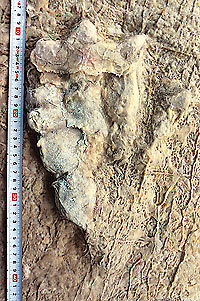 In our first three happenings articles we concentrated on the Moab Megatracksite which represents theropod dinosaur activity on a 150-160 million-year-old, very extensive seashore, now represented by the Middle Jurassic Entrada Sandstone. But dinosaurs were around at least 50 million years earlier, in the Late Triassic and Lower Jurassic. The rock formations in which we find their tracks form part of the Glen Canyon Group which mostly represented an arid, sandy desert environment. The most famous formation from this rock group is the Navajo Sandstone representing fossil sand dunes, as seen at Arches National Park, and named in honor of the Navajo people and their sacred mountain. The Kayenta Formation is also named from this region. Pictographs near Kanab, Utah In our first three happenings articles we concentrated on the Moab Megatracksite which represents theropod dinosaur activity on a 150-160 million-year-old, very extensive seashore, now represented by the Middle Jurassic Entrada Sandstone. But dinosaurs were around at least 50 million years earlier, in the Late Triassic and Lower Jurassic. The rock formations in which we find their tracks form part of the Glen Canyon Group which mostly represented an arid, sandy desert environment. The most famous formation from this rock group is the Navajo Sandstone representing fossil sand dunes, as seen at Arches National Park, and named in honor of the Navajo people and their sacred mountain. The Kayenta Formation is also named from this region. Pictographs near Kanab, Utah -diagram-map.png) show that Native Americans depicted large three toed tracks right beside dinosaur tracksites. These tracks are named Eubrontes meaning “true thunder.” They are 12-18 inches (30-45 cm) long representing carnivorous, theropod dinosaurs up to 15-16 feet (5 meters) long, that perhaps had a ‘thunderous’ step. (Brontosaurus from the Late Jurassic means “thunder lizard”). show that Native Americans depicted large three toed tracks right beside dinosaur tracksites. These tracks are named Eubrontes meaning “true thunder.” They are 12-18 inches (30-45 cm) long representing carnivorous, theropod dinosaurs up to 15-16 feet (5 meters) long, that perhaps had a ‘thunderous’ step. (Brontosaurus from the Late Jurassic means “thunder lizard”).
Eubrontes was first named from Lower Jurassic rocks in New England in the mid-1800s and is today the Connecticut state fossil. So large theropod dinosaurs were abundant in the west and also back east. In the west they occur in layers representing small lakes and ponds in harsh, desert environments. Also found with Eubrontes are smaller tracks, typically 3-6 inches (10-15 cm) long named Grallator and represent turkey-sized theropod dinosaurs. 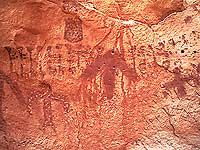 These are among the most common tracks in the Late Triassic, where they are generally smaller, and remain abundant throughout the Jurassic. When first found, also in New England, they were dubbed Noah’s Raven tracks. This tells us that carnivorous dinosaurs of all These are among the most common tracks in the Late Triassic, where they are generally smaller, and remain abundant throughout the Jurassic. When first found, also in New England, they were dubbed Noah’s Raven tracks. This tells us that carnivorous dinosaurs of all  sizes dominated early in the age of dinosaurs. Tracks and bones of herbivorous dinosaurs are generally rare. The most distinctive is the four-toed track Otozoum, meaning “giant animal,” which was made by an ancestor of the vegetarian sauropods or brontosaurs. It too may have grown up to 5 meters long. The first example west of the Mississippi was found in Moab in 1990. Likewise, a rare, small (2 inch long) track named Anomoepus moabensis, from along the Potash road, is a first for the area and may also represent a herbivore. Another common Early Jurassic, 1-2 inch-long, track (named Batrachopus) represents a small crocodile relative. It walked upright unlike today’s modern sprawlers which grew much larger. These small land-based crocs were also carnivores. So what did so many predatory carnivores eat where herbivorous prey was scarce? Paleontologists do not really know and can only suggest that the desert food chain was based on a carnivore-eats-carnivore ecology. Small cat-sized tracks on the actual dune surfaces represent small mammal ancestors, small crow-sized theropods and tracks of spiders and scorpions. This contrasts with the tracks of large theropods (Eubrontes), sauropod ancestors (Otozoum), and small crocs (Batrachopus) found in the ponds and watercourses between the dunes. Pioneer paleontologists working around Moab were surprised to find tracks in rocks representing a harsh desert. But where there is water there is life, tracks and trackers. sizes dominated early in the age of dinosaurs. Tracks and bones of herbivorous dinosaurs are generally rare. The most distinctive is the four-toed track Otozoum, meaning “giant animal,” which was made by an ancestor of the vegetarian sauropods or brontosaurs. It too may have grown up to 5 meters long. The first example west of the Mississippi was found in Moab in 1990. Likewise, a rare, small (2 inch long) track named Anomoepus moabensis, from along the Potash road, is a first for the area and may also represent a herbivore. Another common Early Jurassic, 1-2 inch-long, track (named Batrachopus) represents a small crocodile relative. It walked upright unlike today’s modern sprawlers which grew much larger. These small land-based crocs were also carnivores. So what did so many predatory carnivores eat where herbivorous prey was scarce? Paleontologists do not really know and can only suggest that the desert food chain was based on a carnivore-eats-carnivore ecology. Small cat-sized tracks on the actual dune surfaces represent small mammal ancestors, small crow-sized theropods and tracks of spiders and scorpions. This contrasts with the tracks of large theropods (Eubrontes), sauropod ancestors (Otozoum), and small crocs (Batrachopus) found in the ponds and watercourses between the dunes. Pioneer paleontologists working around Moab were surprised to find tracks in rocks representing a harsh desert. But where there is water there is life, tracks and trackers.
|
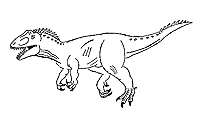
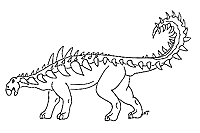
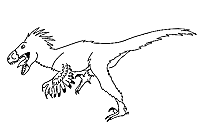
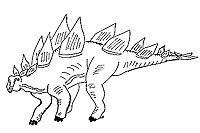
 In our first three happenings articles we concentrated on the Moab Megatracksite which represents theropod dinosaur activity on a 150-160 million-year-old, very extensive seashore, now represented by the Middle Jurassic Entrada Sandstone. But dinosaurs were around at least 50 million years earlier, in the Late Triassic and Lower Jurassic. The rock formations in which we find their tracks form part of the Glen Canyon Group which mostly represented an arid, sandy desert environment. The most famous formation from this rock group is the Navajo Sandstone representing fossil sand dunes, as seen at Arches National Park, and named in honor of the Navajo people and their sacred mountain. The Kayenta Formation is also named from this region. Pictographs near Kanab, Utah
In our first three happenings articles we concentrated on the Moab Megatracksite which represents theropod dinosaur activity on a 150-160 million-year-old, very extensive seashore, now represented by the Middle Jurassic Entrada Sandstone. But dinosaurs were around at least 50 million years earlier, in the Late Triassic and Lower Jurassic. The rock formations in which we find their tracks form part of the Glen Canyon Group which mostly represented an arid, sandy desert environment. The most famous formation from this rock group is the Navajo Sandstone representing fossil sand dunes, as seen at Arches National Park, and named in honor of the Navajo people and their sacred mountain. The Kayenta Formation is also named from this region. Pictographs near Kanab, Utah -diagram-map.png) show that Native Americans depicted large three toed tracks right beside dinosaur tracksites. These tracks are named Eubrontes meaning “true thunder.” They are 12-18 inches (30-45 cm) long representing carnivorous, theropod dinosaurs up to 15-16 feet (5 meters) long, that perhaps had a ‘thunderous’ step. (Brontosaurus from the Late Jurassic means “thunder lizard”).
show that Native Americans depicted large three toed tracks right beside dinosaur tracksites. These tracks are named Eubrontes meaning “true thunder.” They are 12-18 inches (30-45 cm) long representing carnivorous, theropod dinosaurs up to 15-16 feet (5 meters) long, that perhaps had a ‘thunderous’ step. (Brontosaurus from the Late Jurassic means “thunder lizard”).  These are among the most common tracks in the Late Triassic, where they are generally smaller, and remain abundant throughout the Jurassic. When first found, also in New England, they were dubbed Noah’s Raven tracks. This tells us that carnivorous dinosaurs of all
These are among the most common tracks in the Late Triassic, where they are generally smaller, and remain abundant throughout the Jurassic. When first found, also in New England, they were dubbed Noah’s Raven tracks. This tells us that carnivorous dinosaurs of all  sizes dominated early in the age of dinosaurs. Tracks and bones of herbivorous dinosaurs are generally rare. The most distinctive is the four-toed track Otozoum, meaning “giant animal,” which was made by an ancestor of the vegetarian sauropods or brontosaurs. It too may have grown up to 5 meters long. The first example west of the Mississippi was found in Moab in 1990. Likewise, a rare, small (2 inch long) track named Anomoepus moabensis, from along the Potash road, is a first for the area and may also represent a herbivore. Another common Early Jurassic, 1-2 inch-long, track (named Batrachopus) represents a small crocodile relative. It walked upright unlike today’s modern sprawlers which grew much larger. These small land-based crocs were also carnivores. So what did so many predatory carnivores eat where herbivorous prey was scarce? Paleontologists do not really know and can only suggest that the desert food chain was based on a carnivore-eats-carnivore ecology. Small cat-sized tracks on the actual dune surfaces represent small mammal ancestors, small crow-sized theropods and tracks of spiders and scorpions. This contrasts with the tracks of large theropods (Eubrontes), sauropod ancestors (Otozoum), and small crocs (Batrachopus) found in the ponds and watercourses between the dunes. Pioneer paleontologists working around Moab were surprised to find tracks in rocks representing a harsh desert. But where there is water there is life, tracks and trackers.
sizes dominated early in the age of dinosaurs. Tracks and bones of herbivorous dinosaurs are generally rare. The most distinctive is the four-toed track Otozoum, meaning “giant animal,” which was made by an ancestor of the vegetarian sauropods or brontosaurs. It too may have grown up to 5 meters long. The first example west of the Mississippi was found in Moab in 1990. Likewise, a rare, small (2 inch long) track named Anomoepus moabensis, from along the Potash road, is a first for the area and may also represent a herbivore. Another common Early Jurassic, 1-2 inch-long, track (named Batrachopus) represents a small crocodile relative. It walked upright unlike today’s modern sprawlers which grew much larger. These small land-based crocs were also carnivores. So what did so many predatory carnivores eat where herbivorous prey was scarce? Paleontologists do not really know and can only suggest that the desert food chain was based on a carnivore-eats-carnivore ecology. Small cat-sized tracks on the actual dune surfaces represent small mammal ancestors, small crow-sized theropods and tracks of spiders and scorpions. This contrasts with the tracks of large theropods (Eubrontes), sauropod ancestors (Otozoum), and small crocs (Batrachopus) found in the ponds and watercourses between the dunes. Pioneer paleontologists working around Moab were surprised to find tracks in rocks representing a harsh desert. But where there is water there is life, tracks and trackers.